Primary top col ads
Thursday, October 16, 2008
Indian Tourism Offices in Foriegn Countries
Argentina
950-Cordoba Avenue,
9th Floor 'A' 1054,
Buenos Aires,
Argentina
Australia (Sydney)
Level 2, Piccadilly,
210 Pitt Street, Sydney,
NWS-2000
Canada (Toronto)
60, Bloor street (West) Suite 1003,
Toronto,
Onlario M4 W3B 8
France (Paris)
11-13 Bis Boulevard Hausmann,
75008 Paris,
Germany (Frankfurt)
Baseler Strasse-48,
60329, Frankfurt,
AM-MAIN-10
Israel (Tel Aviv)
C/O Indian Embassy 4,
Kolfman Street
Tel Aviv
Italy(Milan)
Via-Albricci 9,
21022 Milan
Japan (Tokyo)
Pearl Buliding 7-9-18-Ginza, Chuo-ku,
Tokyo 104
Netherlands (Amsterdam)
Rokin 9-15 1022
KK Amsterdam
Russia (Moscow)
C/O Embassy of India Moscow
Singapore
20 Kramat Lane, #01-OIA
United House
South Africa (Johannesburg)
PO Box No: 412452, Craig Hall 2024,
South Africa
Spain (Madrid)
Avenida Plo XII 30-32
Madrid 28016
Sweden (Stockholm)
Sveavagen 9-11 S-II 157
Stockholm
UAE (Dubai)
Post Box 12856, NASA Building,
AL Maktoum Road, Deira,
Dubai
UK (London)
7,Cork Street London WIX 2LN
USA (Los Angeles)
3550 Wishire Boulevard,
Room 204, Los Angeles
California 90010
USA (New York)
Suite 1808 1270,
Avenue of Americas New York,
NY-10020.
Friday, September 12, 2008
God’s own country, Kerala celebrates Onam
 e hill stations, rich and varied wildlife and historic monuments, Kerala draws visitors from every nook and corner of the globe. Besides, the South Indian state is equally famous for its colourful festivals and traditional snake boat races. Among the festivals, Onam is the most important and the biggest festival of Kerala. In fact, due to popularity of Onam, the Government of India announced it as a national festival of Kerala in the year 1961.
e hill stations, rich and varied wildlife and historic monuments, Kerala draws visitors from every nook and corner of the globe. Besides, the South Indian state is equally famous for its colourful festivals and traditional snake boat races. Among the festivals, Onam is the most important and the biggest festival of Kerala. In fact, due to popularity of Onam, the Government of India announced it as a national festival of Kerala in the year 1961.An annual harvest festival, Onam begins today (September 12) with traditional gaiety and enthusiasm. People of all ages from children to elders celebrate
 the festival in the traditional way. Onam is one of the most important festivals for Malayalese community, celebrated in the month of Chingam, the first month of Malayalam calendar, generally falls in August - September. Usually the weather seems very pleasant and soothing during Onam and whole Kerala looks green. Leaving behind the religious boundaries the highly spirited Keralan people come outside their houses to celebrate the harvest festival. Farmers also fell very delighted looking at their yield and they express their happiness in their own way.
the festival in the traditional way. Onam is one of the most important festivals for Malayalese community, celebrated in the month of Chingam, the first month of Malayalam calendar, generally falls in August - September. Usually the weather seems very pleasant and soothing during Onam and whole Kerala looks green. Leaving behind the religious boundaries the highly spirited Keralan people come outside their houses to celebrate the harvest festival. Farmers also fell very delighted looking at their yield and they express their happiness in their own way.Legend has it the Onam festival marks the arrival of legendary King Mahabali in the state. It is believed during the rule of demon King Mahabali, the region of Kerala witnessed a golden era. At that time, everybody in the region was happy and prosperous, and they had deep respect and affection for King Mahabali. However, egoism was one of the
 major drawbacks of the King Mahabali that eventually ended his reign. Later, for all his good deeds, God granted King Mahabali a boon that he could annually visit his people. Hence, traditionally people of Kerala make all efforts to welcome their dear King and celebrate the festival in a grand way to impress him as well.
major drawbacks of the King Mahabali that eventually ended his reign. Later, for all his good deeds, God granted King Mahabali a boon that he could annually visit his people. Hence, traditionally people of Kerala make all efforts to welcome their dear King and celebrate the festival in a grand way to impress him as well.According to tradition festivities of Onam lasts for ten days and during this period best of Kerala’s culture and tradition can be observed. Ten days of Onam carnival have been named as Atham (Day 1), Chithira (Day 2), Chodhi (Day 3), Visakam (Day 4), Anizham (Day 5), Thriketa (Day 6), Moolam (Day 7), Pooradam (Day 8), Utharadam (Day 9) and Thiruvonam (Day 10).
Of the ten days, first day Atham and the tenth day Thiruvonam are considered the most important. But in some part of Kerala, ninth day Utharadam is also regarded important from the celebrations point of view. Each day of the Onam is celebrated according to set rituals and traditions by the people of the state.
During the Onam carnival Keralan people remain in complete funn
 y mood and they don’t wish to miss single minute of merriment. Some of the major highlights of Onam include exquisitely decorated Pookalam (Rangoli) with flowers and colours, ambrosial Onasadya, extraordinary Kaikottikali dance and entertaining Snake Boat Race.
y mood and they don’t wish to miss single minute of merriment. Some of the major highlights of Onam include exquisitely decorated Pookalam (Rangoli) with flowers and colours, ambrosial Onasadya, extraordinary Kaikottikali dance and entertaining Snake Boat Race.Onasadya is the most exciting part of Onam celebrations, which is prepared on Thiruvonam, the tenth day of carnival. The grand feast, Onasady is a nine course meal comprised of 11 to 13 essential dishes. After preparation Onadadya is served on banana leaves and people sit on a mat laid on the ground to enjoy the delectable meal.
Snake Boat Race is another thrilling feature of Onam, which takes place on the river Pampa. Numerous colourfully decorated boats competing with each other in the boat race and enthral the crowd.
Monday, August 11, 2008
Sunderbans the home of Royal Bengal Tigers.
In fact, Sunderbans is often compared to the Amazon basin for its biodiversity. The tiger reserve encompasses both land and water and the delta is formed by the meeting of three rivers – the Brahmaputra and Ganges in India and Meghna in Bangladesh. When sailing through the mangrove forests, you will realise that you have reached the sea and there is no sign of land anywhere.
Sunderbans mainly comprises of three islands namely Sandeshkali, Basanti and Goasaba. These three island constitute the northern boundary of the mangrove forest, while the southern side is flanked by the Bay of Bengal. To the west lies the Malta and Bidya rivers, while Bangladesh lies to the east.
The beauty of the fairytale-ish forests unveil as you penetrate deeper and deeper. Within a short while, most probably you will catch a glimpse of the elusive Royal Bengal Tiger. Sanjekhali Sanctuary situated at the junction of Peechkhali and the Gomti river is home to the King of the jungle.
of the elusive Royal Bengal Tiger. Sanjekhali Sanctuary situated at the junction of Peechkhali and the Gomti river is home to the King of the jungle.
The Mangrove Interpretation Centre is a must visit spot in the Sanjeckhali region, The centre houses the various facets of the mangrove forests and make people aware of the requirement to conserve them. The temple of Bon Bibi, the goddess of the forest is another place that deserves a visit.
Sudhankhali Watch Tower, located deep within the Reserve Forest Area is the perfect place to view wildlife. Most wild animals visit the nearby sweet water pond to quench their thirst. If you are lucky enough, you may even spot the tiger. In addition to tigers, you can spot other wild animals such as monkeys, deer, Olive Ridley turtle, a wide variety of fish, red fiddler crabs, hermit crabs, humongous crocodiles etc. Sunderbans is also home to avian species such as kingfishers, plovers, lap wings, white bellied sea eagles, sandpipers, whimbrels, pelicans, curfews and many other species.
Getting Sunderbans
Kolkata is the nearest airport from Sunderbans. River cruise is the best way to reach Sunderbans from Kolkata. You can reach the nearest town Canning and hire a motor launch to reserve. The river cruise will allow you to witness rural life of Bengal and also to enjoy the nature at its best. Foreign nationals require permits from the Secretary, West Bengal Forest Department to travel to the tiger reserve.
Where to Stay
Numerous accommodation options are available at Sunderbans, that include Sundar Chital Tourist Lodge, Sunderban Tiger Camp. Bali Island and Vivada cruises.
Saturday, July 26, 2008
Golden Chariot - Karnataka's first luxury train
Introduced by KSTDC (Karnataka Tourism Department) few months
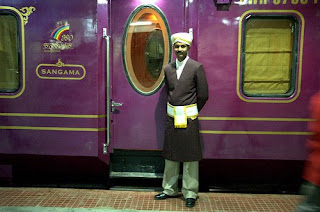 back, the luxury train has become very much popular among the tourists. Named after the popular stone chariot in Hampi, in South India the train travels trough historic heritage sites, magnificent palaces, rich and varied wildlife and golden beaches of Goa. The Golden Chariot’s 7 Nights / 8 Days journey starts every Monday from Karnataka’s capital city Bangalore and finally ends at Bangalore as well.
back, the luxury train has become very much popular among the tourists. Named after the popular stone chariot in Hampi, in South India the train travels trough historic heritage sites, magnificent palaces, rich and varied wildlife and golden beaches of Goa. The Golden Chariot’s 7 Nights / 8 Days journey starts every Monday from Karnataka’s capital city Bangalore and finally ends at Bangalore as well.On your journey you will traverse through Mysore, visiting Srirangapatna, Mysore Palace, Nagarhole National Park (Kabini) and the historical sites of Shravanabelagola. Further you visit Belur-the 11th century cradle of Hoysala architecture and a world heritage site, Halebidu, Hamp. Thereafter you enter into the triangular heritage site of Badami, Pattadakal, Aihole, and finally reach the Golden Beaches of Goa before coming back to Bangalore.
Golden Chariot Journey Details
Places Covered : Bangalore - Mysore - Kabini - Hassan - Hospet - Gadag - Goa - Bangalore
Duration : 07 Nights / 08 Days
Facilities in the Golden Chariot
Golden Chariot is equipped with all the contemporary luxurious amenities, you will yourself like Maharaja. In fact, while traveling you get a wonderful chance to experience th
 e royalty of the bygone era. Highlights of the train are :
e royalty of the bygone era. Highlights of the train are :Coaches – Each coach of the train has been named after the dynasties that ruled Karnataka. The coaches have been named as Kadamba, Hoysala, Rastrakota, Ganga, Chalukya, Bhahamani, Adhilshahi, Sangama, Shathavashna, Yudukula and Vijayanagar. Every coach has fully air-conditioned 26 twin beds, 17 double bed cabins and 1 cabin for the physically challenged.
Each cabin is equipped with Wi-Fi, LCD television, DVD with 6 satellite channels, wardrobe, vanity/writing desk and private bathroom with luxurious amenities and accessories. The chambers in which you travel narrate tales of the Mysore Maharajas. Admire the intricate carvings on the ceiling, the wall panels and furniture inspired by Mysore and Hoysala architecture.
Restaurants – The Golden Chariot has two restaurants namely Nala and Ruchi serving a range of vegetarian and non-vegetarian delicacies. Enjoy the culinary delights of South India in 4-seater and 2-seater dining cabins amidst the interiors inspired by th
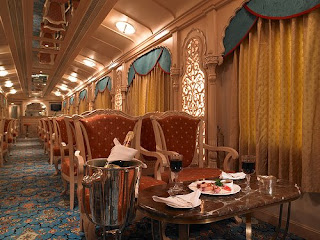 e timeless aesthetics of Hampi and Halebid.
e timeless aesthetics of Hampi and Halebid.Madira (Lounge Bar) – Madira the lounge bar aboard serve invigorating range of spirits alongwith life performance of local artisans. Order the liquor of your choice and relax in the bar, enjoying the soothing music in the royal interiors modeled after the Mysore Palace.
Conference Coach – Conference Coach can accommodate 30 persons and is equipped with 42 inch LCD television and high-speed internet surfing area.
Gym Coach – Gym Coach has fully equipped gymnasium, and ayurveda and spa centre as well. While on board discover age old traditions and cures to modern day stress. The coach has two massage rooms for exhilarating rejuvenation experience. For those who prefer a local flavour - Ayurveda massages are provided.
Thursday, July 10, 2008
Kalka - Shimla Railway now a world heritage property
 ways of India being included in World Heritage list. Other railways include the Darjeeling Himalayan Railway and the Nilgiri Mountain Railway in Tamil Nadu State. Kalka – Shimla Railway is the ultimate victory of style and serendipity over speed and in this route journey is as important as the destination. An extraordinary engineering feat, Kalka - Shimla Railway has its heritage as well cultural values.
ways of India being included in World Heritage list. Other railways include the Darjeeling Himalayan Railway and the Nilgiri Mountain Railway in Tamil Nadu State. Kalka – Shimla Railway is the ultimate victory of style and serendipity over speed and in this route journey is as important as the destination. An extraordinary engineering feat, Kalka - Shimla Railway has its heritage as well cultural values.Considered as the greatest narrow gauge engineering feat in the country, Kalka – Shimla railway line was opened on November 9, 1903 by Lord Curzon, the then Viceroy of India. Still the line doesn’t go faster than 25 km per hour, but according to the railway authorities, in comparison to British period more people are using the line today. The journey begins at Kalka, the track rises from 640 mtr (Kalka) to 2,060 mtr (Shimla), the train passes over 864 bridges, under 102 tunnels (longest tunnel Barog – 1.1 km) and around 900 sharp curves and bends.
The scenery along the Kalka – Shimla route is spectacular – flanked by lofty hills, the line cross through the sides of steep cliffs and ventures over arch bridges. The toy train begins its c
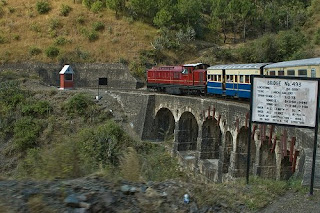 orkscrew ascent immediately above the small town of Parwanoo and enter into the forested hills. After an hour the track straightens out, curving in and out of the hills. There are 18 stations along the way, Barog is the most popular among them. From Barog to Kandaghat, the train crosses the beautiful places of Solan and Saloghra. The final climb of the train starts at Kandaghat, through lush oak and rhododendron forests, Finally, Shimla comes into view as the train winds its way through the picturesque hills to the alpine reaches of the lower Himalayas.
orkscrew ascent immediately above the small town of Parwanoo and enter into the forested hills. After an hour the track straightens out, curving in and out of the hills. There are 18 stations along the way, Barog is the most popular among them. From Barog to Kandaghat, the train crosses the beautiful places of Solan and Saloghra. The final climb of the train starts at Kandaghat, through lush oak and rhododendron forests, Finally, Shimla comes into view as the train winds its way through the picturesque hills to the alpine reaches of the lower Himalayas. An another interesting aspect of the Kalka – Shimla railway is the age-old communication system, which is still in use. Block phones and control phones are being used by the stations en-rou
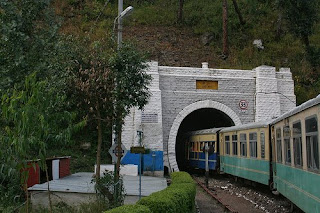 te, the former established links between two stations, while the latter helps to keep in touch with other important stations. Beside, the Red and green lanterns, used as signals in British period are still part of the operating system.
te, the former established links between two stations, while the latter helps to keep in touch with other important stations. Beside, the Red and green lanterns, used as signals in British period are still part of the operating system. Mountain railways is one of the major tourists attractions of India. Developed by the British East India company, about hundred year ago, mountain railways even today serve as the most convenient mode of transport to reach the hill stations. In fact, mountain railways have become the precious jewell in crown of the Indian Railway. Addition of Kalka- Shimla Railway in World Heritage list is a big achievement for Indian Railways. According to reports the Railways are now planning to offer special tour package on Kalka – Shimla rail line.
Tuesday, July 1, 2008
Deccan Odyssey, Maharashtra’s own Palace on Wheels
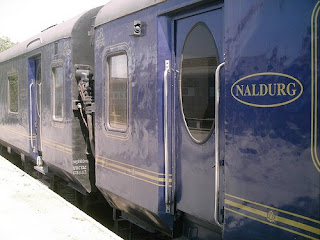 ing terrain of Deccan plateau. All the coaches are named after forts, monuments and historic sites, except the bar, which is called Mumbai High. Each coach has its own lounge, where you can sit during journey. To keep you entertained there are TV – cum – conference room, restaurants, bar, spa, salon and a gym.
ing terrain of Deccan plateau. All the coaches are named after forts, monuments and historic sites, except the bar, which is called Mumbai High. Each coach has its own lounge, where you can sit during journey. To keep you entertained there are TV – cum – conference room, restaurants, bar, spa, salon and a gym.Travelling in Deccan Odyssey is one of the most luxurious ways to closely observe the lives of people living in the virgin, un-touched tourist spots of Konkan, Ratnagiri, Sindhudurg, Pune, Aurangabad and beach paradise Goa.
Deccan Odyssey leaves Mumbai every Wednesday evening and returns to its origin following Wednesday morning. Leaving from Mumbai’s CST (Chhatrapati Shivaji Terminal) the train winds its way through Konkan, Sindhurdurg, on to Goa, through the Deccal plateau and then on to Aurangabad. Last destination of the train is Nasik.
The train makes two stops along the Konkan coast that allow tourists to
 discover the backwaters of Maharashatra and the golden beaches of Ganapathiphule and Tarkarli Beach Resort, as well as visit some of the most famous sea forts of Maharashtra. From here the train runs south to Goa where people on board get the chance to explore the exquisite churches of Old and also relax on one of its serene beaches.
discover the backwaters of Maharashatra and the golden beaches of Ganapathiphule and Tarkarli Beach Resort, as well as visit some of the most famous sea forts of Maharashtra. From here the train runs south to Goa where people on board get the chance to explore the exquisite churches of Old and also relax on one of its serene beaches.Further it turns around and pushes north to Pune, and then covers the heritage circuit of Ajanta and Ellora vaces, with stops at Jalgaon and Aurangabad respectively. While returning back to Mumbai the train swings past Nasik, where passengers get to toast the Maharashtrian odyssey at the Sula Winery.
Tickets for Deccan Odyssey are priced at Rs 15,000 a day all inclusive, except drinks and use of health spa.
Wednesday, June 18, 2008
Monsoon Hot Spots in India
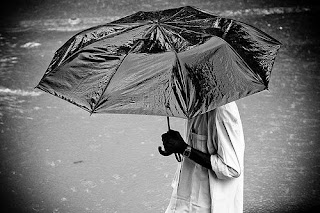 scorching summer heat. In fact, monsoon season in India has now also become popular become among the global trotters. For last few years, Monsoon tourism has emerged as new tourism theme in India.
scorching summer heat. In fact, monsoon season in India has now also become popular become among the global trotters. For last few years, Monsoon tourism has emerged as new tourism theme in India. Travel freak from India and foreign countries throng some of the special locations of India to enjoy the rainy season at its best. India’s capital New Delhi is a famous destination for monsoon season, God’s own Country Kerala, Kolkata and Karnataka are another hot spots. While some visit the Nilgiri hills in South India to see the lush tea gardens and mystic charm around.
Delhi – One of the most famous tourist destinations of world, Delhi is a evergreen place. Delhi is full of places to enjoy the monsoon rains. India Gate, a war memorial situated on Rajpath is the favoured place among the city people and the outsiders as well. During the monsoon season the parks surrounding the monument, turns lush green. Besides, the artificial lakes also get full of water, providing exciting boating opportunity. You can see people enjoying the rains with their families and friends. Purana Quila (Old Fort) in Delhi is another famous place. You can enjoy the boating across the lake adjacent to the fort. Boats are available on rent for half-hour to one-hour at nominal charges. In addition to these, Delhi has a number of parks and gardens where people reach to take a refreshing bath in monsoon rain.
Kolkata – Also called the ‘City of Joy’, Kolkata is one of the four metros of India. Once the capital of India, Kolkata is the capital of state of West Bengal. Due to its location close to the Bay of Ben
 gal, Kolkata receives heavy rains during monsoon. The city has number of spots where people enjoy the rainy season. Victoria Memorial, Alipore Zoo, Maidan are some of the places where you can see large crowd during rains.
gal, Kolkata receives heavy rains during monsoon. The city has number of spots where people enjoy the rainy season. Victoria Memorial, Alipore Zoo, Maidan are some of the places where you can see large crowd during rains.Kerala – God’s own country – Kerala is full of natural wonders. Beaches, backwaters, wildlife, rivers and lakes are some of the attractions of Kerala. During the monsoon these natural wonders become more charming. Some of the must visit places in Kerala are Munnar, Wayanad and Kumarakom. A boat cruise across the Kerala backwaters, is once in a lifetime experience. Periyar lake inside the Periyar Wildife Sanctuary also offers exciting boating option. One can see a variety of wildlife while cruising the lake. Apart from these, Ayurveda in Kerala during monsoon is a thrilling experience. In fact, an Ayurveda vacation in Kerala during monsoon is the finest way to refresh, rejuvenate and renew your body and soul. Tour operators in Kerala offer ‘Monsoon Holiday Packages’ for tourists, covering all important destinations of the state. Monsoon tour packages are available on various options, so feel comfortable and enjoy the rainy season in Kerala this year.
Karnataka – South India state of Karnataka also draws large number of tourists during monsoon. Mangalore, Gokrana and Chickmagalur are some of the famous places of Karnataka that can be
 visited in monsoon season. Situated on the western coast of Karnataka, Mangalore is a small town of narrow winding streets, lofty coconut trees, quaint gable-roofed houses, beautiful beaches, temples and churches. The heady fragrance of the Mangalore ‘Mallge’, the aroma os spicy cocont curries and hustle and bustle of life around a seaport, add more to the charm of the city. Gokarna is a small hill town, located at a distance of 453km from Bangalore.
visited in monsoon season. Situated on the western coast of Karnataka, Mangalore is a small town of narrow winding streets, lofty coconut trees, quaint gable-roofed houses, beautiful beaches, temples and churches. The heady fragrance of the Mangalore ‘Mallge’, the aroma os spicy cocont curries and hustle and bustle of life around a seaport, add more to the charm of the city. Gokarna is a small hill town, located at a distance of 453km from Bangalore.An ancient Shaiva Centre, Gokarna is said to be as important as Kashi and Rameshwar. Mahabaleshwara is one of the important temples here. However, Swaswara, a CGH Earth resort on the Om Beach is highlight of Gokarna which captures solitude, serenity and the ambience of its pristine beaches. Chickmagalur is situated 250 kms from Bangalore, amidst the Bada Budan Hills. A calm and serene hill station, Chickmagalur boasts of scenic vistas, gentle slopes and rugged mountain trails that are a delight for trekkers.
In addition to above mentioned, there are several destinations in India where you can enjoy monsoon season in a very exciting way. So, choose any destination of India this monsoon to experience the nature’s precious gift on your own.
Monday, June 9, 2008
Tsunami Tourism new tourism theme
According to government officials the aim of Tsunami tourism is to preserve the memories of pre-tsunami days and educate visitors about the impact of the disaster. Beside, Tsunami tourism will also prevent the tsunami affected places completely being forgotten in the future. Tsunami affected areas which are supposed to develop as places of tourist interest include Mamallapuram, Poompuhar, Marina, MGR Thittu and Chinnavaykal.
As the intial step, the Cuddalore district administration has identified Chinnavaykal and MGR Thittu islands vacated by fishermen after the tsunami - as the locations to be developed into tourist attractions. The tourism department of Tamil Nadu is planning to obtain funds under the eco-tourism category to develop these islands. Tamil Nadu's tourism secretary, Irai Anbu said, "We will partly fund the projects."
Meanwhile, Ravichandran, the president of Killai town panchayat under which the tsunami-affected islands fall, said the panchayat has submitted a Rs 5 crore proposal to the district administration to build a theme park on MGR Thittu island. Ravichandran said, "The park will preserve memories of the disaster and educate students and tourists about the damage a tidal wave can cause to coastal areas. We don't want these places to be forgotten in the future, like the ancient port of Poompuhar, which was said to be destroyed by a tsunami wave."
Tsunami Tourism will be a hit or not let the time to decide it. But the unique concept of tourism will provide an excellent chance to tourists to get a close look of the worst affected areas. In addition to this, visitors will surely remember the Tsunami affected areas for longtime.
Tuesday, June 3, 2008
Incredible India Campaign Becoming Rural
This past week speaking at a rural workshop Tourism Secretary S. Banerjee said, "While 36 rural tourism sites have been earmarked to come up in the country, of which 15 have already come up, another 14 will start functioning from this October." Banerjee mentioned that "Rural tourism is being given the ministry's highest priority, as it is an innovative tourism product and also benefits the community. Rural tourism products all over the country have now received a fresh, wider projection with 14 more rural sites getting ready, after the first 15 of the ministry's 36 UNDP-partnered rural sites became ready last year."
Elaborating further he said, "The employment potential of tourism has been widely accepted. It not only has socio-economic benefits for rural communities, it also gives support to languishing arts and crafts while showcasing the rich culture and diverse cuisine of the sites. The focus is on promoting tourism that is sustainable, in harmony with the surroundings and promotes art, craft and culture."
Meanwhile Banerjee advised the stakeholders to find effective marketing arrangements, including tie-up with the travel trade at the regional, national and international levels. According to Banerjee the Rural Tourism sites that are almost complete include Hodka (Kachchh district in Gujarat), Kumbalanghi (Ernakulam district in Kerala), Naggar (Kullu district in Himachal Pradesh) and Ballavpur Danga (Birbhum district in West Bengal).
Other sites that would be complete by October 1st this year are Kazhugumalai (Thoothukudi district in Tamil Nadu), Jageshwar (Almora district in Uttarakhand), Nagarnar (Bastar district in Chhattisgarh), Raghurajpur (Puri district in Orissa), Anegondi (Koppal district in Karnataka) and Mukutmonipur (Bankura district in West Bengal).
Monday, May 19, 2008
Eco tourism - An Emerging Travel Theme
What is Eco-tourism?
Eco-tourism means making as little environmental impact as possible and helping the sustain the indigenous populace, thereby encouraging the preservation of wildlife and habitats when visiting a particular place. Eco-tourism has been described by the International Eco-tourism society as "responsible travel to natural areas that conserves the environment and improves the well-being of local people."
Goals of Eco-tourism
Saving the environment around you and preserving the natural luxuries and forest life, is the prime goal eco-tourism. Whether it's about a nature camp or organizing trekking trips towards the unspoilt and inaccessible regions, one should always keep in mind not to create any mishap or disturbance in the life cycle of nature.
Eco-tourism also focuses to encourage and support the diversity of local economies for which the tourism-related income is important. With support from tourists, local services and producers can compete with larger, foreign companies and local families can support themselves. Besides all these, the revenue produced from tourism helps and encourages governments to fund conservation projects and training programs.
Other goals of Eco-tourism include historical, cultural, biological and cultural conservation, preservation, sustainable development etc. Eco-tourism focuses on local cultures, wilderness adventures, volunteering, personal growth and learning new ways to live on our vulnerable planet.
Professionals Involved in Eco-tourism
Many professionals have been involved in formulating and developing eco-tourism policies. Eco-tourism professionals come from the fields like Geographic Information Systems, Wildlife Management, Wildlife Photography, Marine Biology and Oceanography, National and State Park Management, Environmental Sciences, Women in Development, Historians and Archaeologists, etc.
Do’s & Don’ts
In the recent time India too is gathering momentum with more and more travel related organisation's are addressing the needs of the eco-tourists and promoting eco-tourism in the country. Some basic do's and don'ts of eco-tourism in India are as follows :
Do’s
- Carry back all non-degradable litter such as empty bottles, tins, plastic bags etc. These must not litter the environment or be buried. They must be disposed in municipal dustbins only.
- Observe the sanctity of holy sites, temples and local cultures.
- Cut noise pollution. Do not blare aloud radios, tape recorders or other electronic entertainment equipment in nature resorts, sanctuaries and wildlife parks.
- In case temporary toilets are set-up near campsites, after defecation, cover with mud or sand. Make sure that the spot is at least 30 meters away from the water source.
- Respect people's privacy while taking photographs. Ask for prior permission before taking a photograph.
Don'ts
- Do not take away flora and fauna in the forms of cuttings, seeds or roots. It is illegal, especially in the Himalayas. The environment is really delicate in this region and the bio-diversity of the region has to be protected at all costs.
- Do not use pollutants such as detergent, in streams or springs while washing and bathing.
- Do not use wood as fuel to cook food at the campsite.
- Do not leave cigarettes butts or make open fires in the forests.
- Do not consume aerated drinks, alcohol, drugs or any other intoxicant and throw bottles in the wild.
- Do not tempt the locals, especially children by offering them foodstuff or sweets. Respect local
traditions.
- Polythene and plastics are non biodegradable and unhealthy for the environment and must not be
used and littered.
Eco-tourism Spots in India
Eco-Tourism in India is still at a very early stage, but conscious efforts are made to save the fragile Himalayan Eco System and culture and heritage of the indigenous people. Holiday Camping, Hotel accommodation are gathering momentum amongst the metropolis traveller. A plethora of holiday camping options are available in the Himalayan belt, where soft adventure tourism is packaged with holiday camping to create an acceptable eco-tourism product. Some of the important eco-tourism related spots in India include :
Eco-Tourism Pioneers in Kerala - http://www.tourindiakerala.com/
Eco-Tourism Pioneers in South India - http://www.junglelodges.com/
The Himalayan Trout House - Tirthan, Himachal Pradesh - http://www.questrails.com/
The Camp Kyari (one of the finest models of Eco-tourism in the country) - Village Kyari, Ramnagar - http://www.wildrift.com/
Camp Lunagarh - Mori, Uttaranchal - http://www.treknraft.com/
The Himalayan River Runner Camp - Rishikesh, Uttaranchal - http://www.hrr.com/
The OAI Camp - Rishikesh, Uttaranchal - http://www.oai.com/
The Leopard Beach Camp - Rishikesh, Uttaranchal - http://www.snowleopardadventures.com/
For more info about eco-tourism spots in India visit the website :
mediabar
Tags

